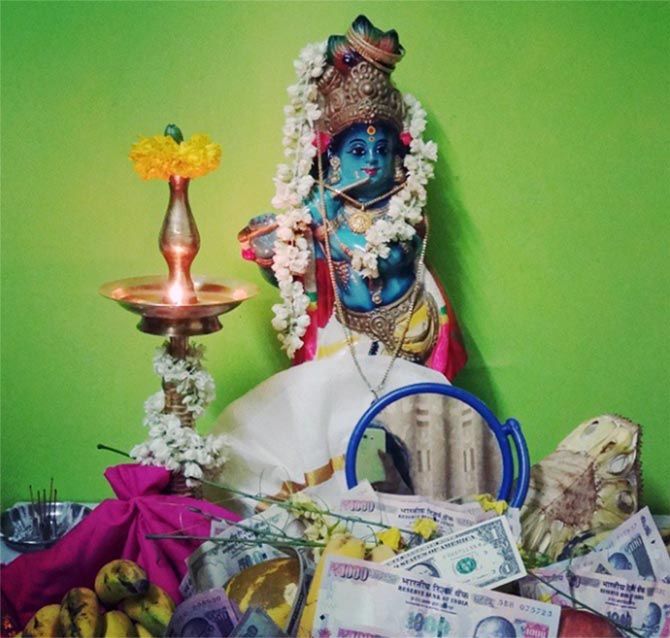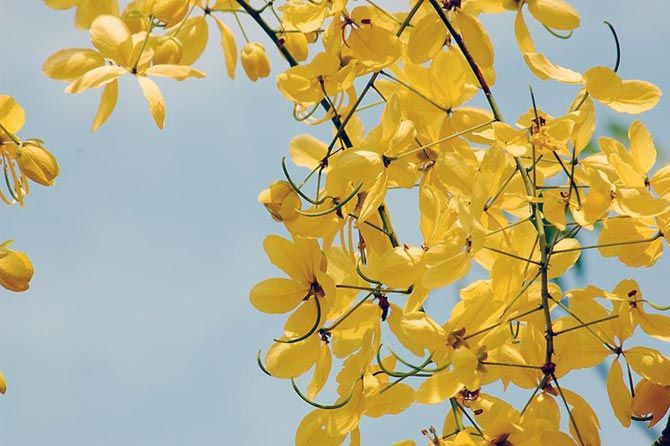Vishu invokes fond memories of childhood writes Divya Nair/Rediff.com

While Onam might be the more popular festival for most Malayalees, ask kids and they'll tell you why Vishu is a favourite.
Vishu, the harvest festival falls in the Malayalam month of Medam -- also the first month of the astrological (zodiac) calendar. It is celebrated as the New Year in Kerala.
The festival, for me, brings along special memories.
As kids, my brother and I would plan our summer vacations around Vishu.
The Maharashtra state board examination would usually end a day or two prior to this festival.
Our train tickets to Coimbatore (where my maternal grandmother lived and other cousins would gather) had to be booked at least two months in advance, yet only the lucky few would manage to get a confirmed ticket.
I have spent very few Vishus in Coimbatore -- with my grandmother and cousins -- and each time it has been special.
The night before Vishu, my veliachhan (uncle) -- one of the eldest male members in my maternal family -- would lock himself in the pooja room for hours together.
He'd carry with him two bags full of vegetables, fruits and colourful flowers. We never really got to see him decorate the room; we only got to see the final result.
He'd say it was a ritual that the eldest member of the family was supposed to decorate the Vishu kani -- the first thing you should see before the break of dawn.
After he sees it, he'd wake up the other family members one by one; the youngest will be the last person to view it.
On Vishu day, at around 4 am, the eldest member of the family, either veliachhan or my grandmother, would blindfold us and direct us towards the pooja room where the kani is displayed.
We'd dip our hands in a bowl of water, while still blindfolded, and wash our eyes.
When we opened our eyes, what we saw would leave us spellbound.
The decorated idol of Krishna would be placed in the centre of the kani and it would be surrounded by fruits, vegetables, grains, gold and silver coins, precious jewellery, holy books and a new piece of cloth -- all of which would be brightly illuminated by the light of the nilavilakku (a traditional bronze oil lamp).

Vishu kani is incomplete without the konna poo (Amaltas or Indian Laburnum flower). The more the better.
And since the kani is the first thing you'd see in the New year, each household decorates it as per their capacity and it is believed to bring in happiness and prosperity for the family.
We are then asked to look into the Aranmula mirror, offer our prayers and seek the blessings of our elders.
My mother would ask us to pinch and eat a small portion of a fruit displayed in the kani and top it with a peppercorn.
The ritual was a reminder that we are ready to welcome the good and the bad the New Year had to offer.
After the Vishu kani, the elders would bless the younger ones with kaineetam -- a coin or a small amount of money -- as a gift. This ritual, needless to say, is what our generation of kids anxiously looked forward to.
My grandmother used to tell us how our great grandfather would distribute new clothes to the domestic help. Even the local farmers would receive a gift -- a coin or new pair of clothes and they'd thank the family by sharing fresh produce from the farm -- fruits, vegetables, etc.

After viewing the Vishu kani, we'd proceed to the gate and burst some padakkam (crackers). In Mumbai, you don't get to buy crackers in April, so we'd save some from Diwali if we could.
According to my grandmother, bursting crackers was a sign that our family seen the kani and a way to announce that our New Year had begun. Soon, our fellow neighbours would follow suit and announce the same. As we got naughtier, we'd burst crackers in front of our neighbours' homes just to wake them up and run away.
Then it would be time to get ready and visit the temple. Most temples would also offer a kaineetam (the amount has changed from 25 paise to one rupee in the last decade) to devotees.
As kids, we'd visit neighbours and seek their blessings.
The real motive, as you might have figured, would be to pocket the kaineetam.
At the end of the day, between the cousins we'd count and compete who'd got more and some of it would be used to buy sweets or ice cream that would be shared by all.
If we were in Mumbai, the celebration would be less grand.
Since we lived in a humble one room kitchen apartment earlier, my parents had the exceptional task to decorate the kani and keep it from our (my brother and I) prying eyes; my mother would usually do it after we went to sleep.
As we grew older, the elders would involve us in the preparation too -- asking us to clean the nilavilakku and run small errands.
But no matter how much we begged, we could never really see the fully decorated kani the night before Vishu. It was always a sight saved for Vishu.
One of the stories my veliachhan and maternal grandmother had told us was that the demon Narakasura was killed by Lord Krishna on this day. And that's why we worshipped Krishna.
The Vishu sadhya is comparatively less elaborate than the Onam sadhya but nevertheless is a good spread of sweet, spicy and savoury dishes.
As we grew older, each of these rituals got smaller or forgotten. Nevertheless, they still hold a special place in our hearts and memories.
Here's wishing everyone a very happy and prosperous New Year.
ALSO SEE Delicious Poila Boishakh recipes









